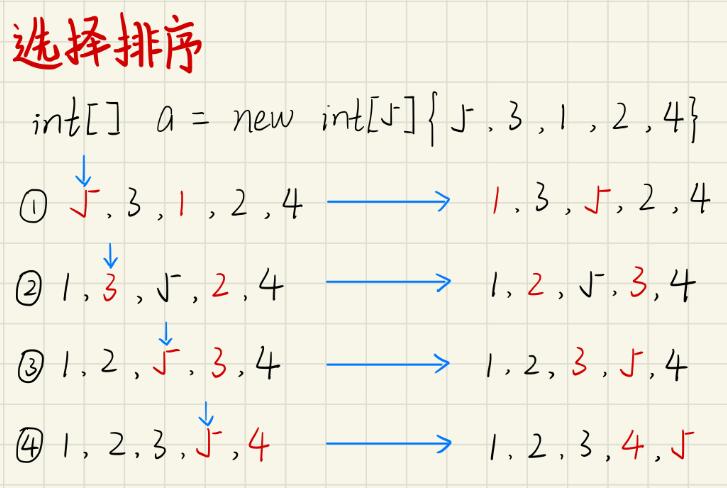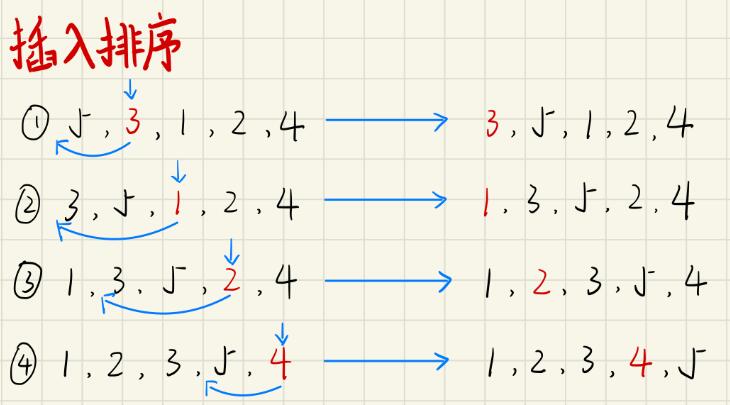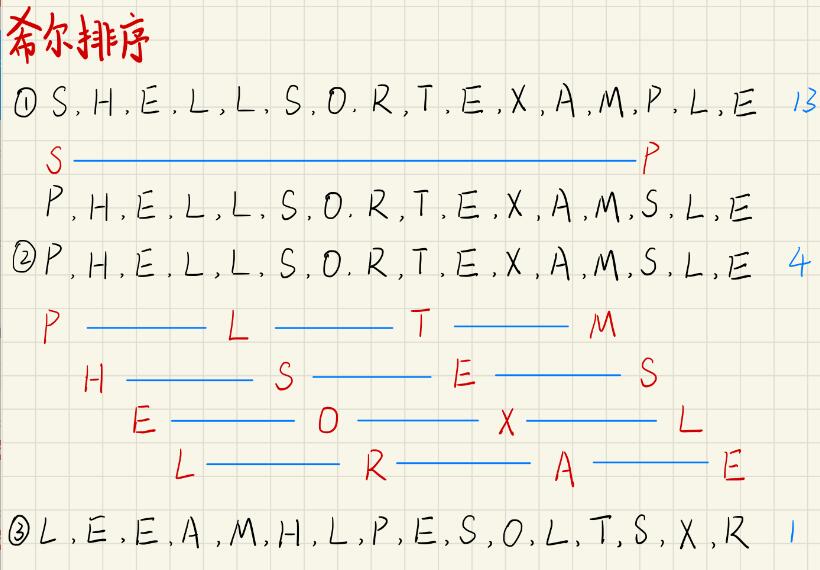本文最后更新于:2023年11月24日 晚上
修改声明
排序算法类模板
该类定义一些排序算法会用到的辅助方法,例如:less和exch方法。前者对元素进行比较,后者交换元素位置。
1
2
3
4
5
6
7
8
9
10
11
12
13
14
15
16
17
18
19
20
21
22
23
24
25
26
27
28
29
30
31
32
33
34
35
36
37
38
39
40
41
42
43
44
45
46
47
48
49
50
51
52
53
54
55
56
57
58
59
60
61
62
| public class Sorts<T> where T : IComparable<T>
{
public static void Sort(T[] a) { }
protected static bool Less(T a1, T a2)
{
return a1.CompareTo(a2) < 0;
}
protected static void Exch(T[] a, int index1, int index2)
{
var temp = a[index1];
a[index1] = a[index2];
a[index2] = temp;
}
public static void Show(T[] a)
{
for (int i = 0; i < a.Length; i++)
{
Console.Write(a[i] + " ");
}
Console.WriteLine();
}
public static bool IsSoreted(T[] a)
{
for (int i = 1; i < a.Length; i++)
{
if (Less(a[i], a[i - 1]))
{
return false;
}
}
return true;
}
}
|
冒泡排序
冒泡排序的基本思想就是:每一趟遍历,都反复比较相邻元素,然后把最大的元素放到数组最后面(保持数组a[a.Length - i...a.Length]有序)。
冒泡排序是稳定的
1
2
3
4
5
6
7
8
9
10
11
12
13
14
15
16
17
18
19
20
21
22
23
24
25
26
| public class Bubble<T> : Sorts<T> where T : IComparable<T>
{
public static new void Sort(T[] a)
{
bool swapped;
for (int i = 0; i< a.Length; i++)
{
swapped = false;
for (int j = i; j < a.Length - 1; j++)
{
if (Less(a[j + 1], a[j]))
{
Exch(a, j, j + 1);
if (!swapped)
{
swapped = true;
}
}
}
if (!swapped)
{
return;
}
}
}
}
|
选择排序
选择排序的基本思想:首先,找到数组中最小的那个元素,其次,将它和数组的第一个元素交换位置。再次,在剩下的元素中找到最小的元素,将它与数组的第二个元素进行交换。如此反复,直到将整个数组排序。
选择排序是稳定的。

1
2
3
4
5
6
7
8
9
10
11
12
13
14
15
16
17
18
| public class Selection<T> : Sorts<T> where T : IComparable<T>
{
public static new void Sort(T[] a)
{
for (int i = 0; i < a.Length; i++)
{
int min = i;
for (int j = i + 1; j < a.Length - 1; j++)
{
if (Less(a[j], a[min]))
{
min = j;
}
}
Exch(a, i, min);
}
}
}
|
插入排序
插入排序的基本思想:从数组的第二个数开始,将它插入到其左边数组中的合适位置,保持左边的数组一直是有序状态,直至数组遍历完成,整个数组都为有序状态。
插入排序是稳定的。

1
2
3
4
5
6
7
8
9
10
11
12
13
| public class Insertion<T> : Sorts<T> where T: IComparable<T>
{
public static new void Sort(T[] a)
{
for (int i = 1; i < a.Length; i++)
{
for (int j = i; j > 0 && Less(a[j], a[j - 1]); j--)
{
Exch(a, j, j - 1);
}
}
}
}
|
要对插入排序进行改进,只需要在内循环中将较大的元素向右移动,而不是每次都进行交换,就能减少一半的数组访问次数,改进后的代码如下:
1
2
3
4
5
6
7
8
9
10
11
12
13
14
15
16
17
18
19
20
21
22
23
24
25
26
27
28
29
30
31
| public class InsertionImproved<T> : Sorts<T> where T : IComparable<T>
{
public static new void Sort(T[] a)
{
int n = a.Length;
int min = 0;
for (int i = 1; i < n; i++)
{
if (Less(a[i], a[min]))
{
min = i;
}
}
Exch(a, min, 0);
for (int i = 2; i < n; i++)
{
T temp = a[i];
int j = i;
while (Less(temp, a[j - 1]))
{
a[j] = a[j - 1];
j--;
}
a[j] = temp;
}
}
}
|
希尔排序
希尔排序其实就是改进过的插入排序,因为插入排序只交换相邻的元素,如果一个很小的元素排在很后面,就需要进行很多次移动,所以希尔排序的思想就是先对数组进行局部排序,交换不相邻的元素,保持数组局部有序,最后再进行一次插入排序来完成排序。
希尔排序的思想是使数组中任意间隔为 h 的元素都是有序的。这样的数组被称为 h 有序数组。换句话说,一个 h 有序数组就是 h 个互相独立的有序子数组编织在一起组成的一个数组。在进行排序时,如果 h 很大,我们就能将元素移动到很远的地方,为实现更小的 h 有序创造方便。

1
2
3
4
5
6
7
8
9
10
11
12
13
14
15
16
17
18
19
20
21
| public class Shell<T> : Sorts<T> where T : IComparable<T>
{
public static new void Sort(T[] a)
{
int n = a.Length;
int h = 1;
while (h < n / 3) { h = h * 3 + 1; }
while (h >= 1)
{
for (int i = h; i < n; i++)
{
for (int j = i; j >= h && Less(a[j], a[j - h]); j -= h)
{
Exch(a, j, j - h);
}
}
h /= 3;
}
}
}
|
编写的测试方法
算法模板类提供了一个IsSorted方法来判断数组是否有序,可以用Debug.Assert来进行测试,不过我这里没用:Debug.Assert(!Sorts.IsSoreted(a), "数组不是有序的");

希望本文章能够帮到您~



